You
can also view the message online

Châtenay-Malabry (FR - 92290), October 03, 2022
EFITA newsletter / 1058 - European Federation for Information Technology in Agriculture, Food and the Environment
The informatique-agricole.org site offers you the possibility of subscribing the RSS feeds of its two newsletters
See RSS feeds to implement to ensure that you continue to receive this newsletter
To unsubscribe this newsletter, please contact me directely: guy.waksman(a)laposte.net if this link Unsubscribe does not work.

To correspond with me (GW), please use this address: guy.waksman(a)laposte.net
To subscribe the efita newsletter (please ask your friends and colleagues to test this link)
Efita Newsletters subscription
Before Computing: German Lanz Typ LD Artillery Tractor
|
See
milinfo.org
29/09/22 This Lanz type LD tractor, produced in 84 units in 1916 and 1917, was first used as a military tractor during the First World War. More specifically, it was an effective pulling device for heavy guns From 1919, the models that survived the war were converted into agricultural tractors. |
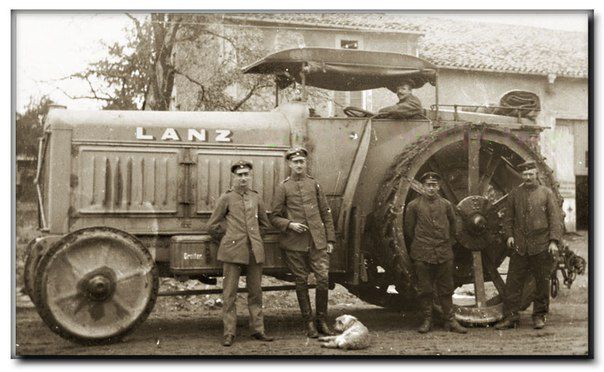 |
Weekly newsletters about ICT in Agriculture in English and French
Both newsletters have around 10000 subscribers.
>>> Last weekly EFITA Newsletters in English (created in 1999) Efita Newsletters
>>> Last weekly AFIA Newsletters in French (created more than 20 years ago in 1997) Afia Newsletters
>>> Statistics for the latest efita newsletter
>>> Latest issue of the afia newsletter
>>> Latest available satistics for the afia newsletter
Les ramasseurs de pommes de terre , 1905 - 1907, de Maurice de Vlaminck (FR, 1876 - 1958), collection Merzbacher, Zurich
| 01 - 29/09/22 |  |
Democratic Values in the Digital Age Series: How can the European Democracy Action Plan empower citizens and build more resilient democracies across the EU?
10 October 2022 - Brussels and on-line
In a healthy and thriving democracy, citizens should be able to freely express their views, choose their political leaders, and have a say about their future. Democracy in the EU faces challenges from rising extremism, election interference, the spread of manipulative information, and threats against journalists. The European Democracy Action Plan is designed to empower citizens and build more resilient democracies across the EU by promoting free and fair elections, strengthening media freedom, and countering disinformation.
Technology is widely perceived as having both positive and negative impacts on democracy. Technology has the power to protect and promote democratic institutions and values rather than undermine them.
See eventleaf.com
La partie de campagne, 1906, de Maurice de Vlaminck
| 02 - 29/09/22 |  |
How did we see the future yesterday??
See the incredible collection developed by Alain Fraval
What is laserweeding? See The Carbon Robotics™ LaserWeeder™
Laserweeding is precision weed control for commercial farming.
Weeds can’t hide in densely planted crops. If we can see ‘em, we can shoot ‘em!
Laserweeding kills weeds dead at the meristem before they compete for precious resources.
Crops grow healthier when they aren’t fighting weeds for water, nutrients, and sunlight.
Farmers have long relied on traditional weeding methods including, herbicides, mechanical weeding, and hand weeding. Each type of weed control presents challenges. Herbicides can impact the health of the crops, mechanical weeding can damage the plants, and hand labor is expensive and challenging to find. Laserweeding is an innovative, reliable, and sustainable solution for farmers and has proven to be effective on more than a dozen crops. The Carbon Robotics™ LaserWeeder™ leverages robotics, artificial intelligence (AI), and laser technology to safely and effectively identify, target and eliminate weeds.
Unlike other weeding technologies, the robots utilize high-power lasers to eradicate weeds using thermal energy, without disturbing the soil. The LaserWeeder™ allows farmers to use less herbicides and reduces labor to remove unwanted plants while improving the reliability and predictability of costs, crop yield, and more.
See carbonrobotics.com
La route de Maurice de Vlaminck (1876-1958)
| 03 - 29/09/22 |  |
FutureFarming.com
> Is no-till the best way to capture and keep carbon in the soil?
New research urges us to take a second look at no-till so that we view it more honestly.
> The benefits of returning cotton textile waste to fields
Field Trials – Getting into the carbon market | Part 1
> Syngenta Interra Scan soil mapping service allows growers to better understand soil health
Syngenta soil mapping service allows growers to better understand soil health
> Video: Autonomous tillage with e-Robotiller
AgroCares and trinamiX jointly offer soil nutrient scanning solution
> CropX launches nitrogen leaching monitoring tool
> InsightTRAC Rover can shoot mummies out of almond trees
The InsightTRAC Rover can remove mummies from almond trees by shooting a biodegradable pellet at it. It prevents pests from damaging the quality and yield of crops. Founder and CEO Anna Haldewang of InsightTRAC explains how Rover works and how it benefits growers.
> Ag robots: Anne Dingstad, CEO Saga Robotics: Increasing adoption of ag robots as more growers ‘get it’
According to Anne Dingstad, the brand-new CEO of Saga Robotics, the time for ag robots is now. “The technology delivers, the numbers stack up.”
> Harvesting… Video: site-specific visual yield determination in seed potato harvesting
Dutch grower Anselm Claasen harvested Agria seed potatoes, using a visual yield determination on his DeWulf potato harvester.
> Crop Health: Digital tool to detect plant-parasitic nematodes in crops through satellite images
Syngenta Crop Protection is launching a commercial digital solution to diagnose infestations of plant-parasitic nematodes in crops by analysing photographs taken from satellites.
> Connectivity: Air gap solution lets farmers deploy machine learning without internet connectivity
To help farmers make sure their (autonomous) agricultural equipment is using all the latest and greatest machine learning models, Wallaroo launches Air Gap Edge Deploy.
> Soil health: Syngenta Interra Scan soil mapping service allows growers to better understand soil health
Interra Scan offers high-resolution soil mapping for up to 27 layers of information, providing growers with precise information on soil health.
See futurefarming.com
What is the youngest age group eligible for COVID vaccination in each country?
At the start of the COVID vaccine rollout, only the oldest age groups in the general population were eligible for vaccination (eligibility often differed for particular at-risk groups).
Over time eligibility was expanded to include younger and younger age groups. Today in the large majority of countries, anyone aged 5 and over is eligible for vaccination. In most other countries the youngest eligible age is 16.
You can explore many more government policy responses to the COVID pandemic on our dedicated page, such as policies for face coverings, travel, gatherings, income support & debt relief, and more — both across countries and over time.
Our source for this data is the Coronavirus Government Response Tracker (OxCGRT), published and managed by researchers at the Blavatnik School of Government at the University of Oxford.
.../...
| See
ourworldindata.org 29/09/22 |
 |
How Digital Technology Can Accelerate Food Sustainability
Digital technologies can be used to address today's challenges while potentially creating new businesses with attractive returns.
See globalagtechinitiative.com
Catch a Glimpse of LATAM’s Fast Precision Ag Evolution
There are few segments of agriculture growing as quickly or garnering as much attention as precision technology.
See globalagtechinitiative.com
Paysages de Maurice de Vlaminck (1876-1958)
| 04 - 29/09/22 |  |
Good to the Last Drop
AquaSpy’s Crophesy technology brings vital irrigation data to growers.
See globalagtechinitiative.com
The Time Is Now for Ag to Close the Connectivity Gap
Without ubiquitous connectivity, ag cannot fully embrace the new tools that will enable it to meet the productivity and sustainability demands of tomorrow.
See globalagtechinitiative.com
Child mortality: an everyday tragedy of enormous scale that we can make progress against
Child mortality is an everyday tragedy of enormous scale that rarely makes the headlines. We live in a world in which 5.4 million children die every year. That’s 10 dead children every minute.
But progress against child mortality is possible. In this article from July 2021, we describe how child mortality has decreased across all countries in the world — but there is large inequality between rich and poor countries, and much progress still to make.
| See
ourworldindata.org 29/09/22 |
 |
Donald Danforth Plant Science Center Partners with Saint Louis University to Deploy Edge Computing to More Broadly Share Farm Intelligence
Researchers to create a cyber-physical system to better share agricultural data among the scientific community.
See globalagtechinitiative.com
Water Management Technology Company Sensoterra Raises EUR 1.0M to Expand Product Offering
Funding will help support expansion of the Dutch company's water management smart soil sensor offering for agriculture and horticulture.
See globalagtechinitiative.com
Personnage dans une rue de village, de Maurice de Vlaminck (1876-1958)
| 05 - 29/09/22 |  |
Key takeaways from Biden's conference on hunger and nutrition in America, NPR, by Ximena Bustillo
President Biden pushed for Congress to permanently extend the child tax credit, raise the minimum wage and expand nutrition assistance programs to help reduce hunger rates as he opened the second-ever conference on food insecurity and diet-related diseases. But the administration faces a sharp uphill battle.
The conference came amid rising food inflation, the end of pandemic benefits that staved off hunger rates and storms on both coasts threatening the food security of millions. The event ties into one of Biden's goals: end hunger in America by 2030 through proposed legislation, regulatory changes and public-private partnerships.
The strategy put forward by the administration includes expanding nutrition assistance programs and launching more healthcare programs to cover medically tailored meals.
"If you look at your child and you can't feed your child, what the hell else matters?" Biden said.
"In America, no child should go to bed hungry. No parent should die of disease that can be prevented," he said.
.../...
See npr.org
Bling Nike more profitable than Adidas
| 01
- 29/09/22 |
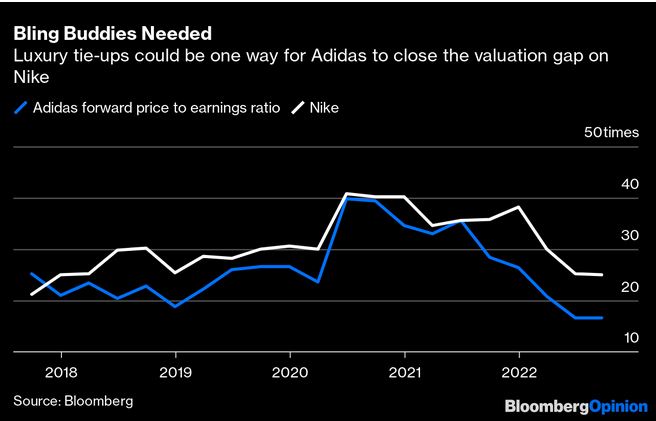 |
The end of the bicycle boom?
| 02 - 29/09/22 | 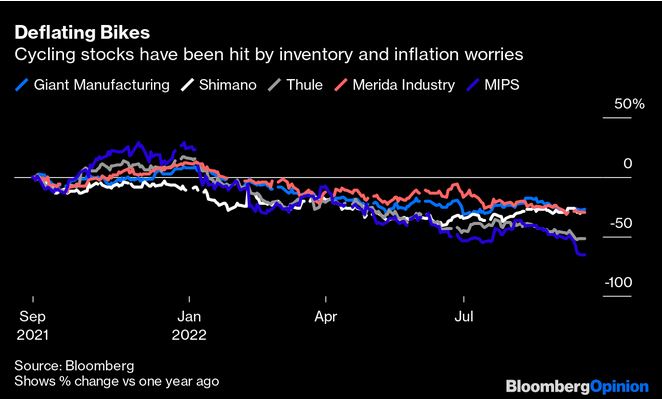 |
Deere’s investment in InnerPlant is about changing Big Ag. More corporates need to follow suit, AFN, by Jennifer Marston
John Deere‘s recent investment in crop health startup InnerPlant is far bigger than the $16 million figure attached to the deal. In many ways, it seems Deere is investing in not one company but an entirely new way of doing crop protection and, ultimately, commodity farming.
InnerPlant announced its Series A earlier this month. John Deere led the round with participation from MS&AD Ventures, Bee Partners and UpWest.
InnerPlant co-founder and CEO Shely Aronov tells AFN that her company started talking to Deere about a year ago. In what she describes as a “really easy” and “frictionless” process, the two companies discussed how to work together more, with Deere eventually suggesting it lead the Series A.
“That wasn’t something we expected, knowing how rare it is that they fund companies,” says Aronov. “I’ve never seen a company move this quick,” she adds.
…/…
See agfundernews.com
Rising interest rates in UK and it is not the end
| 03 - 29/09/22 |  |
Output per hour worked
| 04
- 29/09/22 |
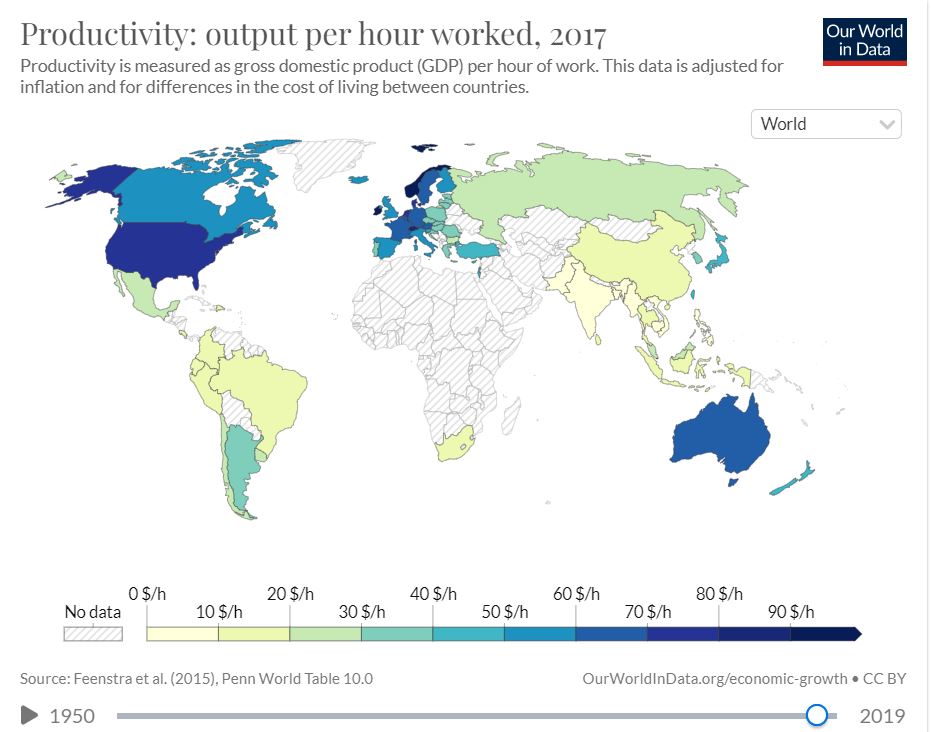 |
John Deere leads InnerPlant’s $16m Series A: The beginning of the internet of plants, published by Upstream Ag Insights by Shane Thomas and Matt Coutts
InnerPlant is developing genetically-engineered varieties of plants that elicit unique signals when they’re experiencing specific stressors. When crops experience fungal pressure, are attacked by insects, lack nutrients, or are thirsty, the leaves fluoresce in different colours, serving as an early warning system for growers.
InnerPlant’s trait technology platform allows remote sensors, such as satellites, to see and understand what a plant is feeling and when, delivering the ability to more proactively and precisely take action and achieve better environmental and profit outcomes.
| 04
- 29/09/22 See upstreamaginsights.substack.com |
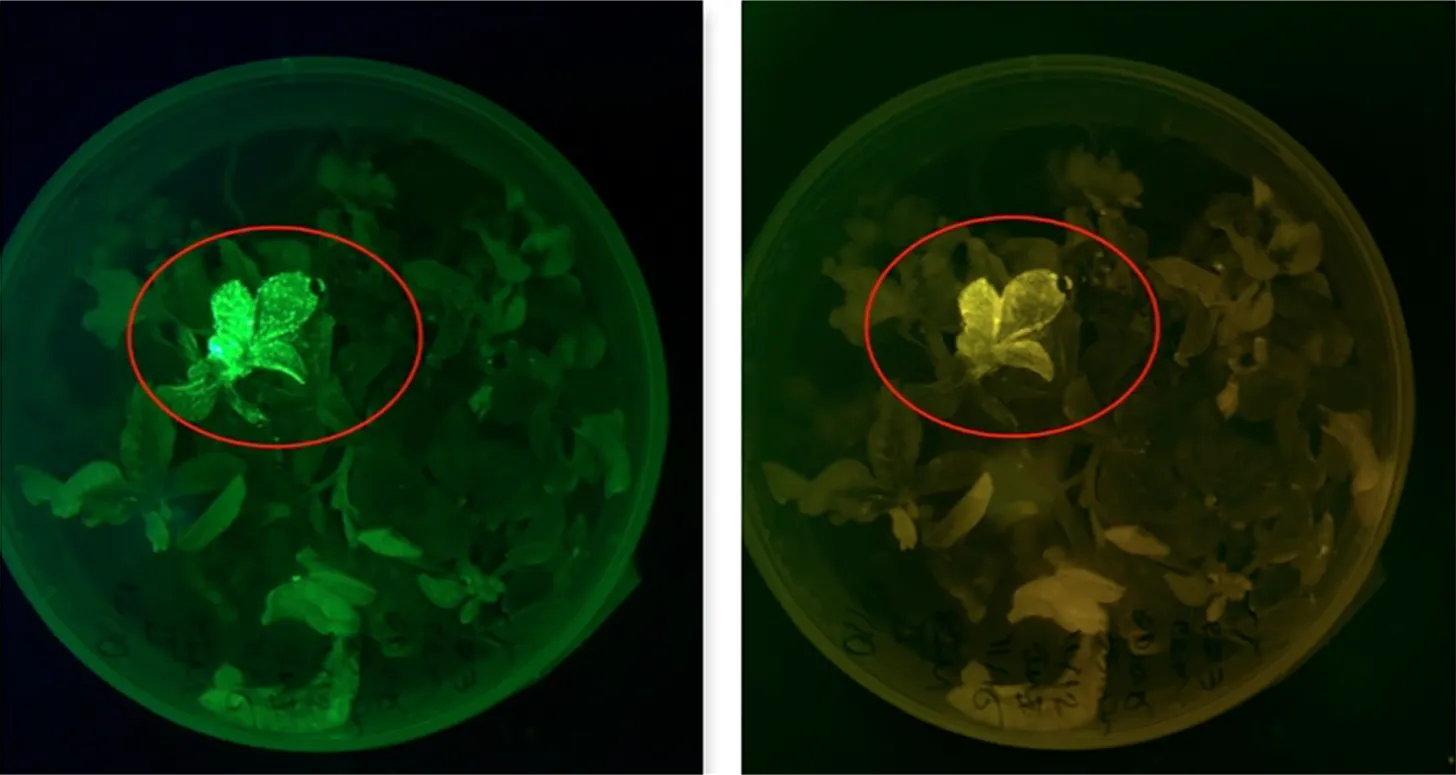 |
Chaumières sur la route, de Maurice De Vlaminck
| 06 - 29/09/22 |  |
Vendease secures $30m Series A as it automates food supply in Africa, AFN, by Lucy Ngige
.../...
Vendease is on a mission to be ‘Africa’s Amazon for food vendors‘ by automating food supply. The realization that Africa’s food markets have their own intrinsic challenges led the startup to create an elaborate food procurement platform that it claims saves restaurants man-hours and offers them stable market prices.
Vendease first launched as an e-marketplace directly linking restaurants and food businesses to farms and food manufacturers. The team went on to add various channels to provide a comprehensive sourcing platform for these food businesses.
These include a user inventory management and invoicing system, logistics services both in tandem with third-party providers and with Vendease drivers for deliveries within 24 hours, as well as a credit offering to its users under a buy-now-pay-later system.
.../...
See agfundernews.com
La récolte dans la tempête, de Maurice De Vlaminck
| 07 - 29/09/22 |  |
Yard Stick lands $18m to equip agrifood with faster, cheaper soil carbon measurement tools, AFN, by Jennifer Marston
Corporate commitments around emissions reductions are on the rise these days, which is creating opportunity for startups developing the next generation of carbon measurement tools. A US-based company called Yard Stick hopes to provide farms with a faster, cheaper and more accurate set of soil carbon measurement tools with which to do this.
With a hardware/software product, Yard Stick provides near-instant carbon measurement, reporting and verification (MRV) to agrifood companies working to lower their carbon intensity.
Six such companies, all partners of Yard Stick, recently received a collective total of $225 million from the United States Department of Agriculture’s (USDA) Partnerships for Climate-Smart Commodities initiative. Yard Stick was chosen as the official soil carbon stock quantification partner for these projects, and will receive $18 million as part of the deal.
.../...
See agfundernews.com
Share of the population using Internet
| 05 - 29/09/22 | 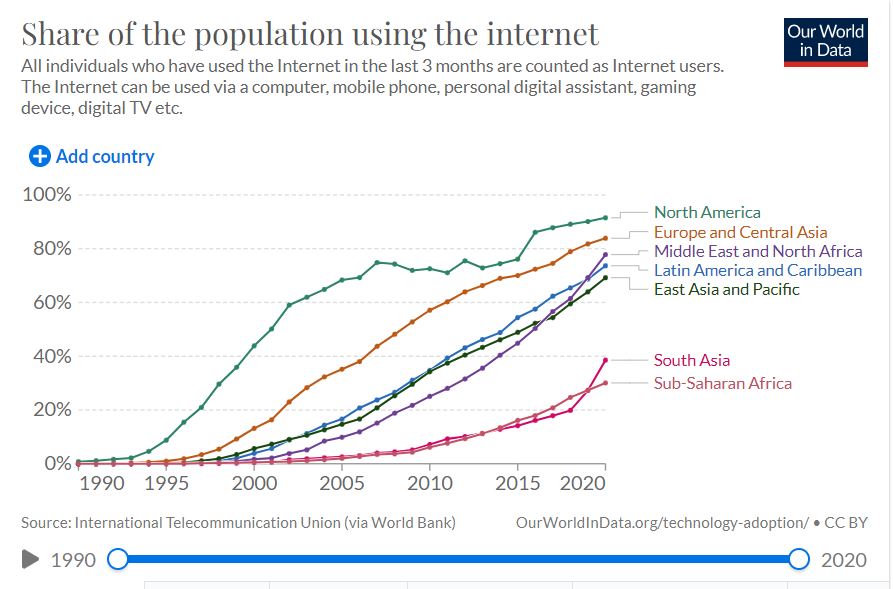 |
The Mighty Dollar
| 06 - 29/09/22 | 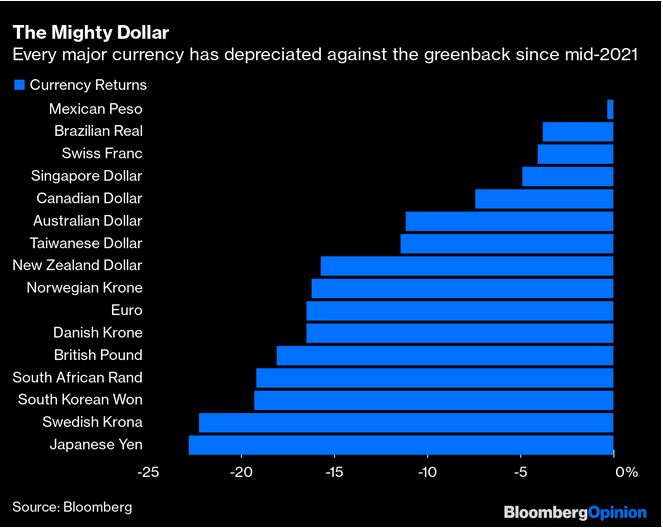 |
Farmerline nets $1.5m from Oikocredit in second close of $14m pre-Series, AFN, by Lucy Ngige
.../...
Farmerline was started with an $800 grant by Alloysius Attah and Emmanuel Owusu Addai in 2013. At the time, it was delivering timely agronomic voice messages to 800 farmers across Ghana through its technology platform Mergdata.
Mergdata, the startup’s own globally-licensed platform, was on Time’s list of the top 100 innovations of 2019. Farmerline has leased Mergdata to over 60 partners mainly in Africa and others in Asia and Latin America, which facilitates farmer profiling, traceability, messaging and digital payments.
It is now looking to evolve the Mergdata platform, making it more AI-powered to deliver intelligence such as crop yield prediction, fertilizer demand forecasting and product traceability needed in the industry. It claims to have reached over 1.5 million farmers in 35 countries via the platform.
Farmerline also offers input financing to farmers through organized groups, climate-smart farming education, logistics services, access to high-quality fertilizer and seeds, and other digital tools while connecting them to agribusinesses in international markets.
It claims to have financed around $18 million worth of inputs and crops through franchise shop alliances with agribusinesses and input dealers.
In Ghana, Farmerline engaged with over 77,000 farmers last year, directly selling products to them and buying their crops. The team projects that this number could go up to 140,000.
.../...
See agfundernews.com
Latin America Growth
| 07 - 29/09/22 | 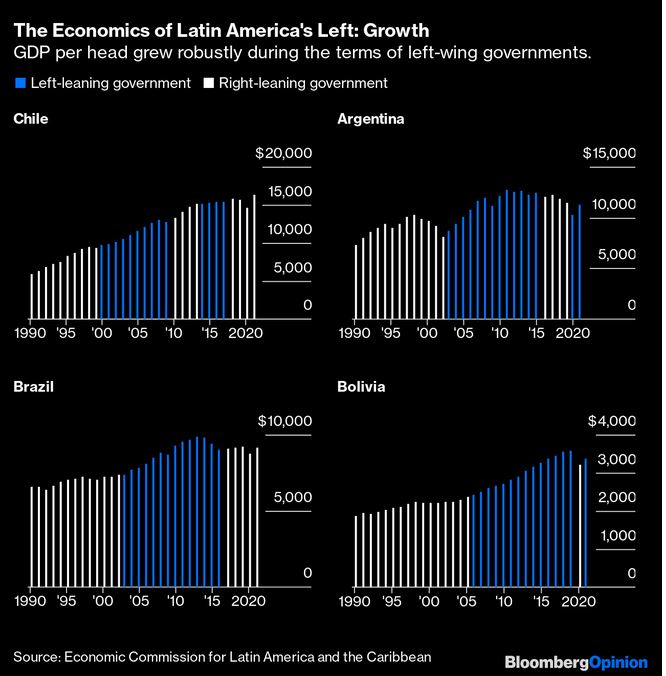 |
Global 2022 AgFunder AgriFoodTech Investment Report
Venture capital investors pumped $51.7 billion into agrifood technologies in 2021; an 85% increase over 2020. The theme of the year: doubling-down (and tripling, and quadrupling-down.) Agrifoodtech sectors that took off in response to the Covid-19 pandemic not only remained the most popular investment categories; they exploded with new deals.
eGrocery registered 188% year-on-year growth, thanks to four 10-figure rounds. Other categories that took off in response to the Covid-19 pandemic continued their acceleration in 2021. Cloud Retail Infrastructure saw its funding grow 97.5% to $4.8 billion, accounting for more than 9% of all investment activity. It tied with Innovative Foods, which grew 103% with more than 430 companies raising funds; familiar names such as Impossible Foods, NotCo, Perfect Day, Future Meat, and Nature’s Fynd were behind the category’s biggest rounds.
See agfunder.com
UK Crisis with higher interest rate
| 08
- 29/09/22 |
 |
Europe 2022 AgriFoodTech Investment Report
Some $9.2 billion dollars was invested in agrifoodtech ventures in Europe in 2021.
Similar to the global agrifoodtech scene, investors mostly backed online grocery ventures and other asset-light downstream technologies. European e-Grocery startups raised $4.2 billion, representing 43% of Europe’s total agrifoodtech investment capital and a 1,300% year-over-year jump.
Where did the rest go?
Of the $2.2 billion dollars invested upstream - in the supply chain and on the farm - Novel Farming Systems received the most amount of investment with nearly $1 billion. After that was Innovative Food with $600 million of investment and then Ag Biotech with $400 million.
Aside from eGrocery, Cloud Retail Infrastructure startups raised just under $1 billion to support the at-home dining trend.
As an addendum to this report this year, we partnered with Invest-NL to look at how much of the year's funding went to climate-related startups: just 27% went to climate-impacting ventures mostly in Novel Farming Systems and Innovative Foods.
See agfunder.com
La moisson, 1945, de Maurice De Vlaminck (1876-1958)
| 08 - 29/09/22 |  |
2022 Africa AgriFoodTech Investment Report
In the past five years, early-stage investors have pumped more than $1 billion into African startups innovating for the food and agriculture industry, achieving a record-breaking $482 million in 2021 alone. That was a 250% jump year-over-year, but still represents less than 1% of global agrifoodtech investment.
Given the African continent is home to 16.7% of the global population, and the food and agriculture industries represent a significant component of most African economies, there clearly remains a shortfall of funding on the continent.
See agfunder.com/
|
Gazette
de vitisphere.com, |
Success of experimental Alzheimer’s drug hailed as ‘historic moment’, by Hannah Devlin, 28 Sep 2022
Study shows cognition in early-stage patients on lecanemab declines by 27% less than those on placebo.
See theguardian.com
Adapting Dietary Guidelines for Vegetarians, Vegans
An Agricultural Research Service nutritionist conducted a study that examined the Dietary Guidelines for Americans and found that altering its Healthy Vegetarian Dietary Pattern could help people who choose certain types of vegetarian diets or who are vegan meet their dietary goals. Learn more about this research.
See usda.gov
A first thought for today
Most people are mirrors, reflecting the moods and emotions of the times; few are windows, bringing light to bear on the dark corners where troubles fester. The whole purpose of education is to turn mirrors into windows.
Sydney J. HARRIS, journalist and author (1917-1986)
A second thought for today
Whenever 'A' attempts by law to impose his moral standards upon 'B', 'A' is most likely a scoundrel. -H.L. MENCKEN, writer, editor, and critic (1880-1956)
A third thought for today
You desire to know the art of living, my friend? It is contained in one phrase: make use of suffering.
Henri Frederic AMIEL, philosopher and writer (1821-1881)
Losses of electric vehicle manufacturers
| 09
- 29/09/22 |
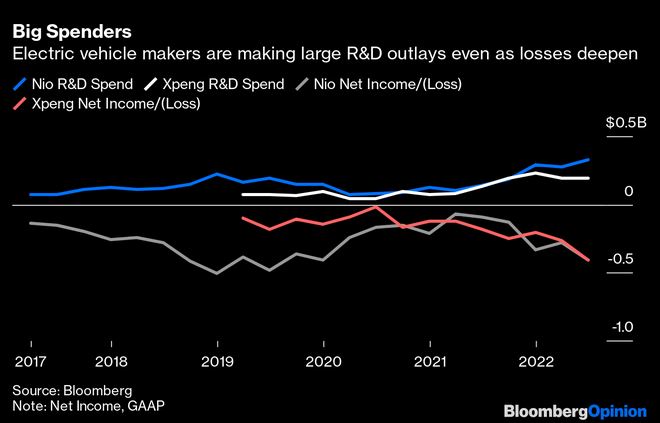 |
CRISPR tackles deadly cassava mosaic virus disease, by Joseph Opoku Gakpo, September 1, 2022
Work has begun to possibly develop CRISPR cassava varieties that are resistant to the deadly cassava mosaic disease (CMD), after an international team of research scientists managed to identify a gene responsible for the resistance.
The team, led by Wilhelm Gruissem, a professor of Plant Biotechnology at the Swiss Federal Institute of Technology in Zürich (ETH Zurich), finally pinned down the gene responsible for what is known as the cassava mosaic disease 2 (CMD2) resistance in some cassava cultivars. Working with several resistant and susceptible West African cassava cultivars, the team used elaborate and time-consuming genome analyses to identify the gene responsible for a specific resistance to cassava mosaic virus. The research team included scientists from National Crops Resources Research Institute in Uganda, Donald Danforth Plant Science Center in St. Louis, Missouri, and the University of California, Los Angeles.
The gene that has been identified now serves as a genetic marker for breeders, indicating whether the resistance is present in their plants, and can be used in guiding development of resistant varieties. In an interview with the Alliance for Science, Gruissem explained that about 30 years ago, farmers in West Africa found cassava plants in the fields damaged by CMD that looked healthy, indicating they were resistant. Although the trait can be introduced in other cassava cultivars using conventional plant breeding processes, such efforts are usually time consuming, and the improved varieties do have undesired traits as well.
See allianceforscience.cornell.edu
When anti-agricultural activism becomes part of politicians’ playbooks, by Amanda Zaluckyj, September 02, 2022
.../...
Consider Greenpeace’s nonsensical opposition to genetically modified crops. The activist organization has promoted outright falsehoods and lies about GMO crops — online and in other formats — for years. As a result some Southern African governments decided it was better to let their residents starve than distribute GMO grains sent by other countries. And everyone knows that Greenpeace’s obstruction of Golden Rice prevented the GMO rice from reaching children with vitamin deficiencies. But even a letter from 159 Nobel Laureates begging them to stop with the disinformation couldn’t convince them.
There’s plenty of other examples, like GMO labeling, that I could point to. Unfortunately, we’re increasingly living in a post-truth world where most people only surround themselves with people they want to believe. And, if anything, it’s only getting worse. So while standing up to these coordinated attacks when they first develop on social media might not be fun and sexy, it’s more important than ever.
See agdaily.com
Job search methods 2008 (before Internet)
| 10 - 29/09/22 | 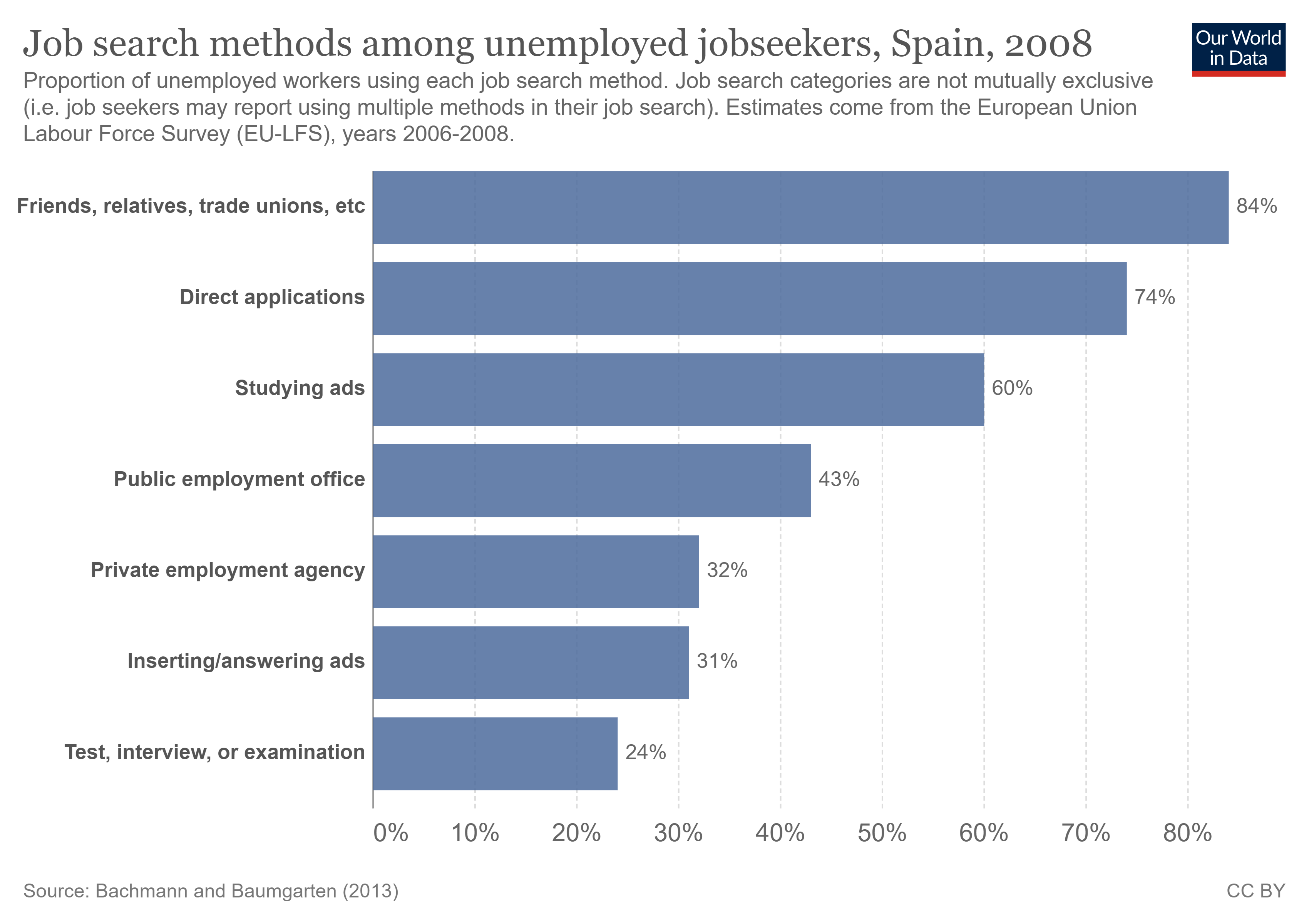 |
Job search methods 2015 (with Internet)
| 11 - 29/09/22 | 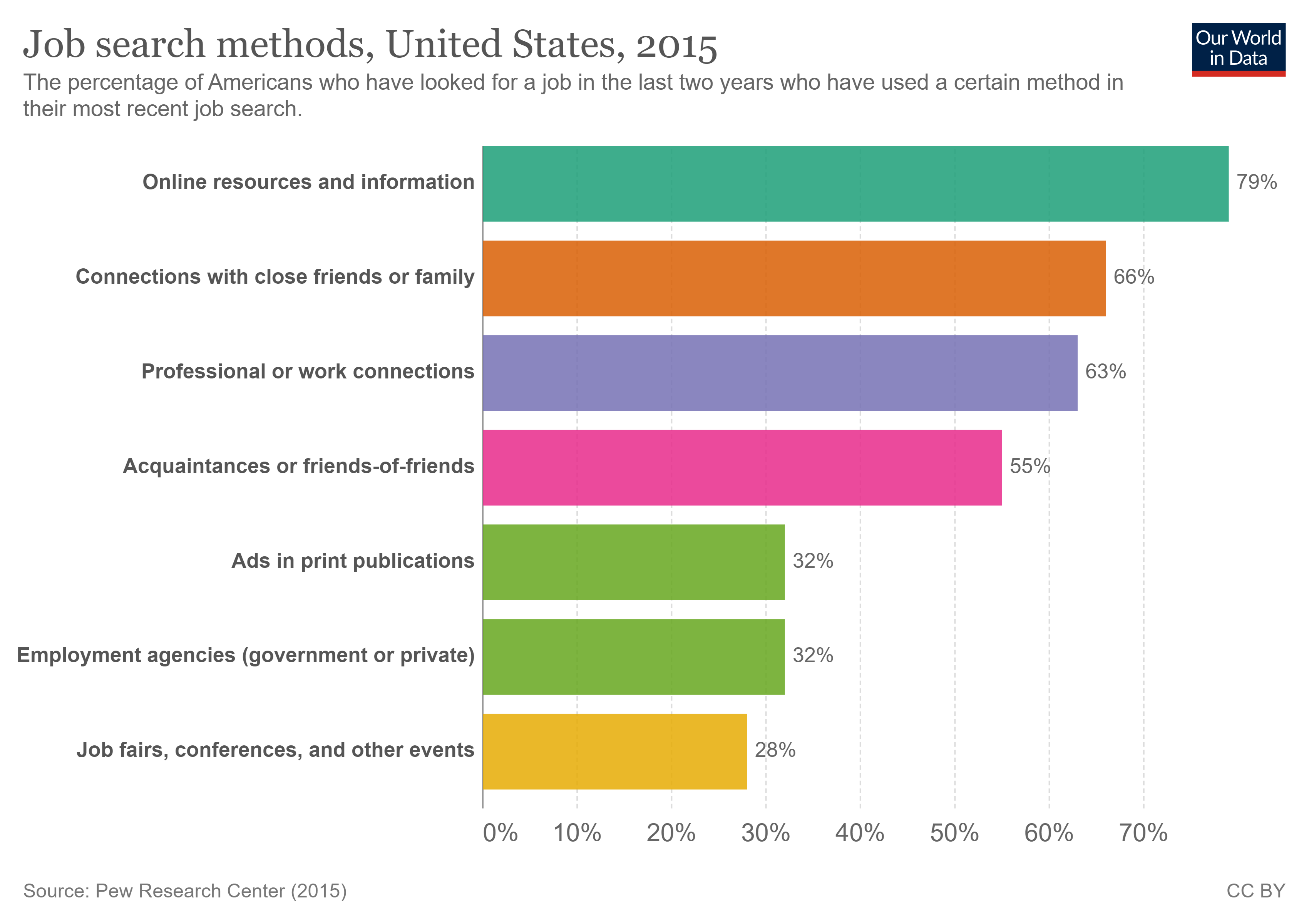 |
How England became Anglo-Saxon
The genetic make-up of people in south and east England changed radically between the Iron Age and the early medieval period, suggesting that there was a huge influx of Anglo-Saxon settlers from northern Europe. Researchers did a genome-wide analysis of 460 people who lived between AD 200 and 1300 in what is now England, Ireland, the Netherlands, Germany and Denmark. Early on, almost all the English people’s ancestors were from the British Isles. Later, they derived an average of 76% of their ancestry from continental northern Europeans.
The finding overturns a favoured hypothesis that Anglo-Saxon culture promulgated in Britain thanks mostly to small incursions of elite warriors. “We’re a million miles away from an invasion hypothesis — it’s not a bunch of blokes getting in boats with weapons and conquering territory,” says archaeologist and co-author Duncan Sayer. “Actually, the North Sea was a highway, where people were coming and going,” says archaeologist Catherine Hills.
See science.org
Patagonia’s billionaire owner gives away company to fight climate crisis
Founder Yvon Chouinard announced that all the company’s profits will go into saving the planet.
See theguardian.com
Le pré, de Maurice De Vlaminck
| 09 - 29/09/22 |  |
China’s hidden epidemics, by Martin Farrer, Wed 21 Sep 2022
Stratospheric economic growth since the late 1970s has brought great prosperity, along with ‘western-style’ health problems that are beginning to have a devastating impact
China faces a health emergency from “hidden epidemics’’ of diseases such as cancer, heart trouble and diabetes that could have far-reaching social, economic and demographic consequences for the world’s most populous nation, experts have warned.
Although China imposed the world’s strictest lockdowns to protect its people from Covid-19, the deadly impact from non-communicable diseases is much less well understood and threatens to kill tens of millions of Chinese in the coming decades without tougher public health policies.
China has been transformed in recent decades by an economic miracle that has seen rapid industrialisation and the transfer of hundreds of millions of people from the countryside to towns and cities.
This enormous change has lifted multitudes out of poverty and given them a better standard of living than they enjoyed in rural areas. But along with higher wages and urban living have come “western” diseases such as cancer linked to very high rates of smoking, and diabetes and heart disease thanks to a richer diet, lack of exercise and high blood pressure.
…/…
See theguardian.com
Le tracteur rouge de Maurice De Vlaminck (1876-1958, France)
| 10 - 29/09/222 |  |
"Jews in Medicine" Presented by The Genesis Prize Foundation
The Jewish commitment to saving and preserving life dates back thousands of years. Throughout history, Jews have been at the forefront of medicine as surgeons and scientists, nurses and neurologists, and many other medical professions. In the modern era, more and more Jews joined the medical profession, and our representation in medicine became far greater than our percentage of the world population.
Jews invented some of the most significant medical innovations of our time, including the pill camera, the Heimlich maneuver, and the world's first 3D printed heart made with actual human cells. And over the past two years, Jewish doctors and scientists have helped lead the way out of the COVID pandemic, the world's worst public health crisis in a century.
This video premiered at the 2022 Genesis Prize award ceremony held in Jerusalem to honor Dr. Albert Bourla, Chairman and CEO of Pfizer.
See genesisprize.org
See this impressive video
And about the Jewish religion, see…
The most climate-friendly seafood
Replacing meat with certain types of sustainably sourced seafood could help people to reduce their carbon footprints without compromising on nutrition, finds an analysis of dozens of marine species that are consumed worldwide. The study points to options that generate fewer greenhouse-gas emissions and are more nutrient-dense sources of protein than beef, pork or chicken:
- Farmed bivalves: shellfish. such as mussels, clams and oysters
- Wild-caught pink salmon (Oncorhynchus gorbuscha) and sockeye salmon (Oncorhynchus nerka)
- Wild-caught, small, surface-dwelling (pelagic) fish, such as anchovies, mackerel and herring
Whitefish, such as cod (Gadus sp.), also had a low climate impact, but were among the least nutrient-dense food. Wild-caught crustaceans had the highest emissions, with a carbon footprint rivalled only by that of beef. The authors note that their emissions data do not include ‘post-production’ emissions, such as those generated by refrigeration or transport.
See nature.com
The Tugboat, 1905, par Maurice de Vlaminck
| 11 - 29/09/22 |  |
10 Useful Websites That Will Save You Hundreds of Hours of Your Life. Most are completely Free, by Jerry Keszka
Like most people, you spend a lot of time online. Between work, family, and other responsibilities, finding the time to do anything else is hard. But did you know that you could save hundreds of hours of your life by using some fantastic websites?
From time-saving tools to helpful resources, these websites are a must-have in your internet arsenal. So be sure to check them out and start saving time today!
.../...
See medium.com
Guatemala’s rainforest is expanding thanks to community efforts
The forests of the Maya Biosphere Reserve are growing rather than shrinking, because of a community-led conservation programme.
See newscientist.com
Le Peuple de Maurice De Vlaminck (1876-1958, France)
| 12 - 29/09/22 |  |
A very devout Jew, Saul, is always there for minyan, he never misses shul…
One day he’s at temple, and he starts praying and says, “God, I never asked you for anything, but I would like to win the lottery.”
And he comes back the next week and he says, “I never asked you for nothing, I helped build this synagogue. I do everything for the Jewish people. I don’t understand it. I asked you for one thing, just one thing, and you couldn’t make it happen.”
He comes back the next week, and it’s the same thing. “What kind of God are you? I never ask for anything. One time, I just wanted to get one thing from you, God.”
And the heavens open up, and there’s thunder and lightning, and God speaks and says, “Saul, help me out, buy a ticket.”
| |
The distribution of this efita newsletter is sponsored by vitisphere.com
Please, contribute to the content of your efita newsletter, and advertise your events, new publications, new products and new project in this newsletter. Without your support, it will not survive!
Contact: Guy WAKSMAN
E-mail: guy.waksman(a)laposte.net
To read this newsletter on our web site
See Efita
The archives of this newsletter
See Efita
Do not miss the Virus Jokes in English and French
About the EFITA mailing list
You can use the efita moderated list (> 15000 subscribers) to announce any event / product / web site / joke (!) related to IT in agriculture, environment, food industry and rural areas.
If you want to subscribe a friend, please fill in his form.
If you do not wish to receive our messages, please fill in the following form...
